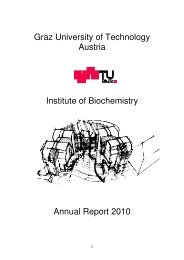Staff Members of the Institute of Biochemistry, TU - Institut für ...
Staff Members of the Institute of Biochemistry, TU - Institut für ...
Staff Members of the Institute of Biochemistry, TU - Institut für ...
Create successful ePaper yourself
Turn your PDF publications into a flip-book with our unique Google optimized e-Paper software.
Previous investigations in our laboratory were aimed at <strong>the</strong> molecular biological<br />
identification <strong>of</strong> novel components involved in PE homeostasis <strong>of</strong> <strong>the</strong> yeast Saccharomyces<br />
cerevisiae. For this purpose, a number <strong>of</strong> genetic screenings were performed. To obtain a<br />
global view <strong>of</strong> <strong>the</strong> role <strong>of</strong> PE in <strong>the</strong> cell and to study <strong>the</strong> effects <strong>of</strong> an unbalanced PE level we<br />
recently subjected a psd1∆ deletion mutant and <strong>the</strong> corresponding wild type to DNA<br />
microarray analysis and examined genome-wide changes in gene expression caused by a<br />
PSD1 deletion. Comparison <strong>of</strong> <strong>the</strong> gene expression pattern <strong>of</strong> <strong>the</strong> psd1∆ mutant with <strong>the</strong><br />
wild-type led to <strong>the</strong> identification <strong>of</strong> 55 differentially expressed genes. Grouping <strong>of</strong> <strong>the</strong>se<br />
genes into functional categories revealed that PE formation by Psd1p influenced <strong>the</strong><br />
expression <strong>of</strong> genes involved in diverse cellular pathways including transport, carbohydrate<br />
metabolism and stress response. Most <strong>of</strong> <strong>the</strong> proteins identified are present in <strong>the</strong> cytosol<br />
followed by <strong>the</strong> nucleus, cellular membranes, <strong>the</strong> cell wall and mitochondria. Moreover, this<br />
genome-wide analysis identified a number <strong>of</strong> gene products with unknown function which<br />
are currently subjected to detailed molecular analysis addressing PE homeostasis in <strong>the</strong> yeast.<br />
16<br />
Figure 1:<br />
Three-dimensional reconstruction <strong>of</strong><br />
yeast cells grown on oleic acid.<br />
Transmission electron micrographs <strong>of</strong><br />
ultrathin sections (A, C; bar = 1µm)<br />
and corresponding 3D reconstructions<br />
<strong>of</strong> serial sections (B, D) <strong>of</strong> a<br />
chemically fixed wild type cell are<br />
shown. Cells shown in A and B were<br />
grown on YPD, and cells shown in C<br />
and D were grown on oleic acid to<br />
induce formation <strong>of</strong> peroxisomes. CW<br />
cell wall; ER endoplasmic reticulum;<br />
LP lipid particle; M mitochondrion; N<br />
nucleus; V vacuole; PX peroxisomes.<br />
By courtesy <strong>of</strong> G. Zellnig, KFUG.<br />
To understand cellular PE homeostasis in some more detail, we performed experiments<br />
defining traffic routes <strong>of</strong> PE within <strong>the</strong> yeast cell. In recent studies, we investigated<br />
peroxisomes and <strong>the</strong> plasma membrane as destinations for PE distribution. These two<br />
membranes have in common <strong>the</strong>ir lack <strong>of</strong> capacity to syn<strong>the</strong>size PE. We employed yeast<br />
mutants bearing defects in <strong>the</strong> different pathways <strong>of</strong> PE syn<strong>the</strong>sis and demonstrated that PE<br />
formed though all four pathways can be supplied to peroxisomes and to <strong>the</strong> plasma<br />
membrane. The fatty acid composition <strong>of</strong> peroxisomal and plasma membrane phospholipids<br />
was mostly influenced by <strong>the</strong> available pool <strong>of</strong> total species syn<strong>the</strong>sized, although a certain<br />
balancing effect was observed regarding <strong>the</strong> assembly <strong>of</strong> PE species into <strong>the</strong> two target<br />
compartments. We assume that <strong>the</strong> phospholipid composition <strong>of</strong> peroxisomes and <strong>the</strong> plasma<br />
membrane is mainly affected by <strong>the</strong> syn<strong>the</strong>sis <strong>of</strong> <strong>the</strong> respective components and subject to<br />
equilibrium, and to a lesser extent affected by specific transport and assembly processes.














